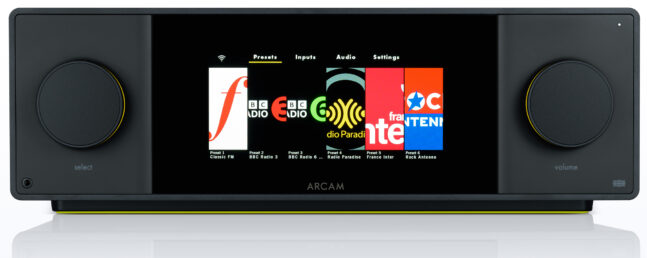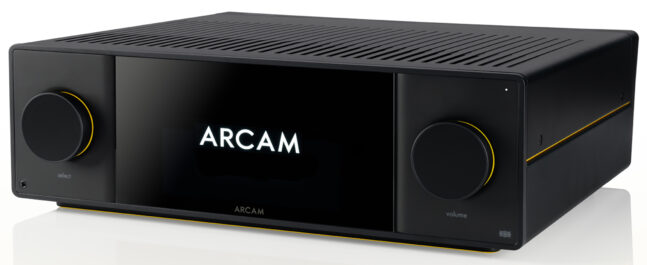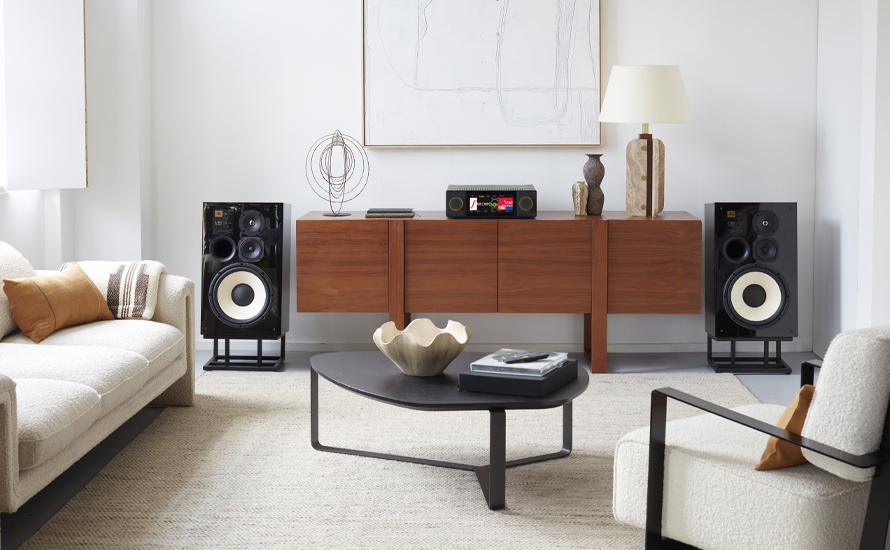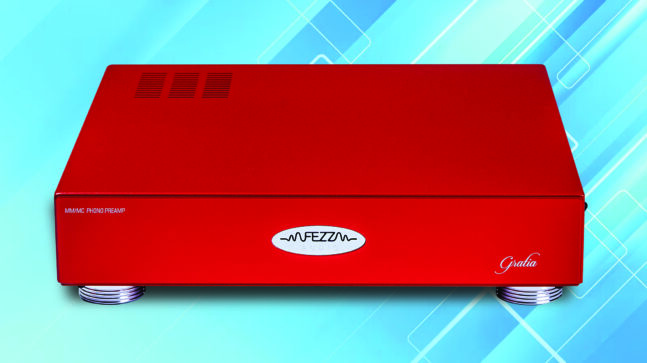The Pinnacle of the New Radia Series
The Cambridge, UK-based manufacturer Arcam was founded in 1976. Over nearly four decades, it has produced several amplifier models, some designed for home theater. Over the years, CD players and even external DACs have been added to the Arcam catalog. Today, the brand is owned by the Harman group, which itself is under Samsung. More recently, I had the opportunity to test the duo formed by the A15 integrated amplifier and its ST5 network music player, which I found to be a revelation in the entry-level category. When I was offered the chance to test the SA45, the flagship integrated amplifier of the Radia series, I didn’t hesitate for a second to say yes. It was first unveiled at the 2024 Munich High-End Show, which doesn’t make it brand new, but its availability in our stores is relatively recent. Let’s take a closer look at what this powerhouse really has under the hood, and whether it offers the same strong value proposition.
The Radia Family
The series now includes seven products, among them three integrated amplifiers: the A5 (entry-level), the A15 (mid-tier), and the A25. All three were introduced in 2023, accompanied by the CD5 CD player and the ST5 network music player (streamer). In October 2024, another streamer, the ST25, was released, featuring a color display and an upgraded streaming platform. Later that same year, two more integrated amplifiers appeared: the SA35 and the SA45. These are true all-in-ones, incorporating both a DAC and a streaming function modeled on the ST25’s platform.
The Radia SA45 Amplifier
This integrated amp is Arcam’s latest achievement after more than 45 years of amplifier design and manufacturing. The very first model, released in 1976, was the A&R Cambridge A60. The new SA45, a true all-in-one, comes with an 8.8” color TFT screen, powered by a GPU tied to its new streaming platform. While its glass display isn’t touch-sensitive, Wi-Fi and Ethernet compatibility make the streaming platform easy to control via Arcam’s free Radia app for Android and Apple devices. It supports major services like Tidal Connect, Spotify Connect, and Qobuz, as well as Google Chromecast, Apple AirPlay, and Roon.

The SA45’s menus can be navigated with push-button controls — a volume knob and a source selector — or via the remote control. It also comes with a microphone for measuring the acoustics of your listening room. With its Dirac Live feature, the SA45 can adjust its response curve to the acoustic properties of the space it’s installed in.
 Digital inputs include two TOSLINK optical, two coaxial, and one HDMI eARC —an upgrade over the three more affordable Radia models. There’s also a USB-A input for flash drives or external hard drives containing music files, effectively turning the SA45 into a music server. With its RJ45 Ethernet port and UPnP support, the SA45 also allows network playback and automatic software updates.
Digital inputs include two TOSLINK optical, two coaxial, and one HDMI eARC —an upgrade over the three more affordable Radia models. There’s also a USB-A input for flash drives or external hard drives containing music files, effectively turning the SA45 into a music server. With its RJ45 Ethernet port and UPnP support, the SA45 also allows network playback and automatic software updates.
Digital-to-analog conversion is handled by an ESS Sabre Hyperstream IV multi-channel DAC, offering four selectable digital filters. The differences are subtle but allow some tailoring of sound. Bluetooth connectivity is the latest standard, and the unit works both as a receiver and transmitter —perfect for wireless headphone listening.
On the analog side, the rear panel offers three unbalanced line inputs and a preamp output on RCA connectors. It also includes one pair of balanced XLR inputs and outputs, along with two phono inputs (one MM, one MC). Add to that two independent subwoofer outputs (RCA or XLR), which can be tuned separately based on their position in the room or if using different subwoofer brands.
Physically, the SA45 is heavier (17 kg) and larger (432 × 390 × 140 mm) than any other Radia amplifier. Yet, it retains the black-and-yellow aesthetic that gives the Radia line its modern, distinctive look. Power is rated at 180 W per channel into 8 ohms, rising to 300 W into 4 ohms. The output stage uses Arcam’s proprietary fifth-generation Class G topology, meaning the SA45 should have no trouble driving virtually any loudspeaker, even the most demanding ones.
 Arcam’s Class G
Arcam’s Class G
To better understand this technology, Arcam compares Class G to a hybrid car with two engines. One smaller engine runs in Class A, while a larger one in Class A/B kicks in only when needed. In practice, Class G uses dual power supplies: one for low-level listening in Class A, and a second, higher-powered supply that activates progressively when dynamics demand it, running in Class A/B. This provides extra power only when required, much like a turbocharger.
The switchover is seamless, fast, and without delay. Since the Class A supply is lower powered, it avoids crossover distortion (typical of Class A/B) and excess heat (typical of Class A). At normal listening levels, you’re in Class A most of the time. At higher levels or with demanding speakers, the Class A/B supply takes over. In other words, you get the strengths of both amplifier classes without their downsides.
Test Conditions
I paired the SA45 with my Monitor Audio Studio 89 loudspeakers. Initially, I listened without a subwoofer to gauge the SA45’s character. Later, I added my REL T/7X subwoofer, which helped distribute bass more evenly in my 260 sq. ft. living room. I did not use Dirac Live calibration, as it requires a laptop, downloaded software, and the included microphone — a process best left to a qualified dealer. Fortunately, my room is already well-damped, with minimal standing waves.
 Using UPnP, the SA45 easily accessed my CeolBOX music server and my Qobuz subscription. I also tested the front-panel 3.5 mm headphone jack with my two reference headphones: the HiFiMan Sundara and Aune AR5000. Both performed well, though the Aune gained extra punch and dynamics thanks to its higher sensitivity. Since I no longer own a turntable, I couldn’t test the MM/MC phono stage, but given the SA45’s build quality, I expect it to be more than respectable.
Using UPnP, the SA45 easily accessed my CeolBOX music server and my Qobuz subscription. I also tested the front-panel 3.5 mm headphone jack with my two reference headphones: the HiFiMan Sundara and Aune AR5000. Both performed well, though the Aune gained extra punch and dynamics thanks to its higher sensitivity. Since I no longer own a turntable, I couldn’t test the MM/MC phono stage, but given the SA45’s build quality, I expect it to be more than respectable.
Listening Impressions
With headphones, the SA45’s headphone output proved perfectly capable. It easily drove my power-hungry Sundara, and with the Aune AR5000, I enjoyed added dynamics and punch. Transparency was such that differences between the two headphones were clearly audible.
Through speakers, the SA45 impressed with both authority and finesse —truly an iron fist in a velvet glove. The SA45 demonstrates a beautiful neutrality, without becoming cold or disembodied. My Studio 89 speakers are renowned for projecting a wide and deep stereo image. In this sense, the SA45 served my speakers superbly well, whose image seemed extrapolated from my usual listening. It delivered neutrality without coldness, with a wide, deep soundstage. Adding the subwoofer elevated the experience to one resembling much larger speakers.
High frequencies extended smoothly without harshness, even on Peter Gabriel’s i/o album, which alternates between dynamic Bright-Side Mixes and gentler Dark-Side Mixes. The SA45 kept the treble controlled and listenable. Midrange transparency revealed textures in voices and acoustic instruments, while soundstage width gave vocalists breathing space.

I continue with the excellent Turkish composer Mercan Dede, who combines traditional Sufi music with electronic music. This multi-instrumentalist composer plays the ney, a long traditional reed flute, and he is very proficient with percussion instruments like the bendir. He also plays the oud, a plucked string instrument similar to the guitar. On the album entitled 800, he is accompanied by five Turkish musicians as well as the singer Yildiz Tilbe, also from Turkey. Bassist Mich Gerber is of Swiss origin. Mercan Dede‘s compositions are melodic and can easily be used as soundtracks for films. These recordings are always of excellent quality, and the amplifier delivers them with the most demonstrative clarity and definition. All of this is achieved without falling into an overly forward presentation that would otherwise want to impress. Once again, the dynamics are there, with crisp and frank percussion strikes. Obviously, the electronic low frequencies are there with imperial control both on my solo speakers and when they are supported by my subwoofer.
I’ll finish with the excellent Sohn, a British musician, producer, and composer from London. In his 2022 album Trust, he doesn’t hesitate to mix a few acoustic instruments with electronically produced sounds and sound effects. His compositions are also very melodic, and their mix immerses us in a spacious and captivating musical atmosphere. The SA45 projects us into this universe thanks to a well-layered stereo image that extends well beyond the speaker’s frame. This image is full of a multitude of well-defined sonic details, superbly distributed throughout the stereo space. This album, Trust, perfectly exploits the entire frequency range from the highest notes to the lowest. In this sense, the SA45‘s tonal balance is most satisfying and musical as desired. All types of music are well served, from the calmest and ethereal classical to the most thunderous rock. In short, the all-in-one SA45 is an excellent instrument for musical reproduction that expresses itself perfectly in its modernity.
Conclusion
At $7,600 (before taxes), the SA45 can’t be considered entry-level like the A15 / ST5 duo I reviewed earlier, which at $2,700 total remains an incredible bargain. Instead, the SA45 targets a different audience — one seeking a powerful, high-performing all-in-one. With five components in a single chassis — a preamp, power amp, headphone amp, DAC, and network player — it competes strongly with setups that would otherwise cost significantly more, not to mention require extra interconnect cables.
With its extensive connectivity, Dirac Live room correction, and Bluetooth transmitter/receiver function, the SA45 is a complete solution. I am seriously considering purchasing one myself, as it would replace my six separate components and simplify the cabling chaos currently cluttering my audio rack. The Arcam SA45 integrated amplifier is now available at select retailers in Quebec.
Mediagraphy
Peter Gabriel, i/o, FLAC 24 bits / 96 kHz
Mercan Dede, 800, FLAC 16 bits / 44.1 kHz
Sohn, Trust, FLAC 24 bits/ 44.1 kHz
José James, No Beginning No End, FLAC 24 bits / 48 kHz
Billie Eilish, Hit me Hard and Soft, FLAC 24 bits / 44 1kHz
GENERAL INFORMATION
Price: $7,600
Warranty: 5 years, parts and labor
Distributor : Erikson Consumer, T. : 1 800.567.3275
https://www.arcam.co.uk/
https://jamindustries.com/#eriksonmultimedia





